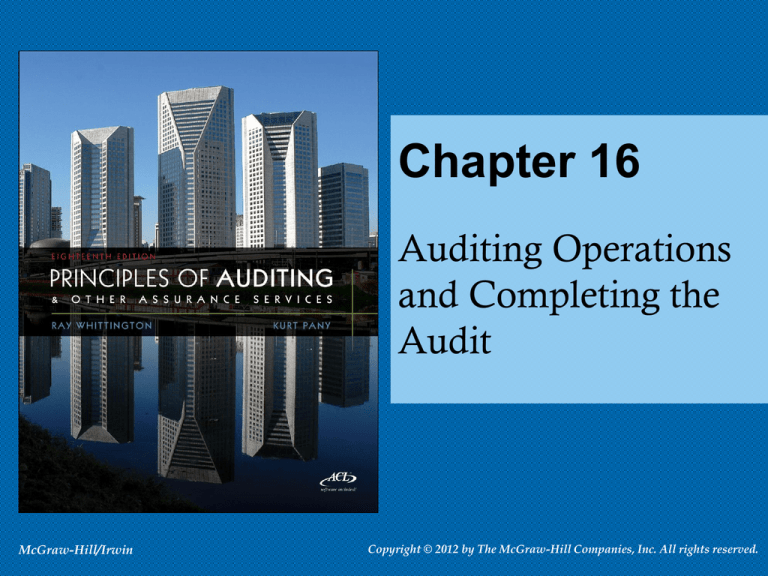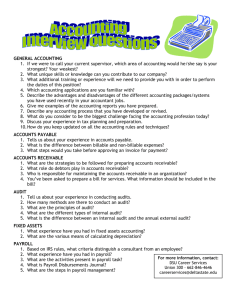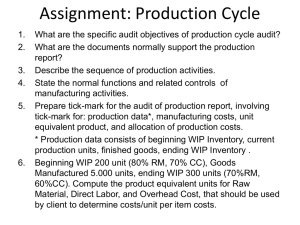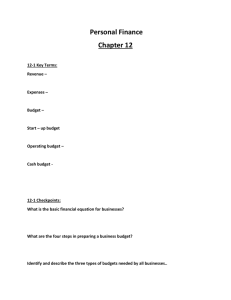
Chapter 16
Auditing Operations
and Completing the
Audit
McGraw-Hill/Irwin
Copyright © 2012 by The McGraw-Hill Companies, Inc. All rights reserved.
Auditing Operations
Corporate
earnings are considered as an
extremely important indicator of health and
well-being of corporations
Measurement of income is generally
regarded as the single most important
function of accounting
16-2
Conservatism in the
Measurement of Income
Powerful influence on revenue and expenses
Important because of subjectivity involved
with accounting estimates
Assets – accountants choose lower of two or
more reasonable alternative values
Liabilities – higher amount is chosen
Results in income statement with a low or
conservative income figure
16-3
Objectives for audit of revenue
and expenses
1. Use the understanding of the client and its environment to consider
inherent risks, including fraud risks, related to revenues and expenses.
2. Consider internal control over revenues and expenses.
3. Assess the risks of material misstatement of revenues and expenses and
design further audit procedures that:
a. Establish the occurrence of recorded revenue and expense
transactions.
b. Determine the completeness of recorded revenue and expense
transactions.
c. Establish the accuracy of revenue and expense transactions.
d. Verify the cutoff of revenue and expense transactions.
e. Determine that the presentation and disclosure of revenue and
expense accounts are appropriate, including the proper
classification of amounts and the proper presentation of earningsper-share data.
16-4
Figure 16-1 Comparative Income Statement Analysis
16-5
Relationships Between Balance Sheet
and Income Statement Accounts
Balance Sheet Item
Revenue
Accounts receivable
Sales
Notes receivable
Securities and
investments
Interest,
Interest, dividends,
gains, investee’s income
Inventories
Property, plant and
equip.
Intangible assets
Prepaid expenses
Accrued liabilities
Interest-bearing debt
Expenses
Uncollectible
accounts
Uncollectible notes
Losses
Purchases, cost of
goods sold, payroll
Rent, gains
Royalties
Depreciation; repairs
Amortization Various
expenses Various
expenses
Interest
16-6
Misc. Revenue (1 of 2)
Mixture of minor items, some nonrecurring and others
received at regular intervals
Auditor should analyze account to look for items
improperly recorded as miscellaneous:
Collections on previously written-off accounts or notes
receivable
Write-offs of old outstanding checks or unclaimed
wages
Proceeds from sales of scrap
Rebates or refunds of insurance premiums
Proceeds from sales of plant assets
16-7
Misc. Revenue (2 of 2)
Auditor
should
Propose adjusting journal entry to classify
items correctly
Perform analytical procedures and investigate
unusual fluctuations
• Can detect material amounts of unrecorded
revenue and
• Significant misclassifications affecting revenue
16-8
Figure 16-2 Professional Fees Analysis
16-9
Substantive Tests for Selling, General
and Administrative Expenses (1 of 2)
Perform analytical procedures
Develop an expectation of the account balance
• Use budgeted amounts, prior-year audited balances,
industry averages, relationships among financial
data and relevant nonfinancial data
Determine the amount of difference from the
expectation that can be accepted without investigation
• Use estimates of materiality
Compare the company’s account balance with the
expected account balance
Investigate significant deviations from the expected
account balance
16-10
Substantive Tests for Selling, General
and Administrative Expenses (2 of 2)
Obtain or prepare analyses of selected
expense accounts
Examine accounts based on results of analytical
procedures
Which accounts? AICPA suggests
• Advertising
• Research and development
• Legal expenses and other professional fees
• Maintenance and repairs
• Rents and royalties
Obtain or prepare analyses of critical
expenses in the income tax return
16-11
Payroll
Importance – typically largest operating cost
Payroll fraud had been common and often
substantial but now fraud difficult to conceal
because of:
Extensive segregation of duties relating to
payroll
Use of computers with proper controls for
preparation of payrolls
Filing of frequent payroll reports to the
government
16-12
Segregation of Functions--Payroll
Separate departments should handle:
• Employment (personnel)
• Timekeeping
• Payroll preparation and record keeping
• Distribution of pay to employees
16-13
Internal Control over Payroll
Documentation
Typical
questions
Are employees paid by check or direct deposit?
Is a payroll bank account maintained on an imprest basis?
Are the activities of timekeeping, payroll compilation, payroll
check signing, and paycheck distribution performed by separate
departments or employees?
Are all operations involved in the preparation of payrolls
subjected to independent verification before the paychecks are
distributed?
Are employee time reports approved by supervisors?
Is the payroll bank account reconciled monthly by an employee
having no other payroll duties?
16-14
Audit Program for Payroll (1 of 2)
1. Perform tests of controls over payroll transactions for
selected pay periods, including the following specific
procedures:
a. Compare names and wage or salary rates to records maintained by the
human resources department.
b. Compare time shown on payroll to time cards and time reports approved
by supervisors.
c. If payroll is based on piecework rates rather than hourly rates, reconcile
earnings with production records.
d. Determine basis of deductions from payroll and compare with records of
deductions authorized by employees.
e. Test extensions and footings of payroll.
16-15
Audit Program for Payroll (2 of 2)
1. Perform tests of controls over payroll transactions for
selected pay periods, including the following specific
procedures (continued):
f. Compare total of payroll with total of payroll checks issued.
g. Compare total of payroll with total of labor cost summary prepared by
cost accounting department.
h. If wages are paid in cash, compare receipts obtained from employees
with payroll records.
i. If wages are paid by check, compare paid checks with payroll and
compare endorsements to signatures on withholding tax exemption
certificates.
j. If wages are paid by direct deposit, compare listing of employee
payments with payroll and direct deposit authorizations.
k. Observe the use of time clocks by employees reporting for work and
investigate time cards not used.
16-16
Substantive Procedures for Payroll
16-17
Audit of Statement
of Cash Flows
Amounts
are audited in conjunction with
the audit of balance sheet and income
statement accounts
Presentation and disclosure important
audit objective is important
Operating
Investing
Financing
16-18
Audit Procedures Completed
Near the End of Field Work
Search
for unrecorded liabilities
Review the minutes of meetings
Perform final analytical procedures
Perform procedures to identify loss
contingencies
Perform the review for subsequent
events
Obtain the representation letter
16-19
Loss Contingencies
Loss contingencies should be reflected in the
financial statement amounts when:
It is probable that a loss had been sustained before
the balance sheet date
The amount of the loss can be reasonably estimated
Loss contingencies should be disclosed in the
notes to the financial statements when it is at
least reasonably possible that a loss has been
sustained
Loss contingencies need not be disclosed when
the possibility of loss is remote
16-20
Litigation
common loss contingency – pending
or threatened litigation
Most
Letter of inquiry to client’s legal counsel
• Evidence of pending and threatened litigation
• Unasserted claims - need to be disclosed if
probable and reasonably possible
SAS 12
• Auditors should obtain from management a list
describing and evaluating threatened or pending
litigation
16-21
Other Contingencies
Income
tax disputes
Accommodation endorsements and other
guarantees of indebtedness
Accounts receivable sold or assigned with
recourse
Environmental issues
Commitments
General risk contingencies
16-22
Audit Procedures for Loss
Contingencies
1. Review the minutes of directors’ meetings to the date of completion
of fieldwork.
2. Send letter of inquiry to client’s lawyer
3. Send confirmation letters to financial institutions to request
information on contingent liabilities of the company.
4. Review correspondence with financial institutions for evidence of
accommodation endorsements, guarantees of indebtedness, or
sales or assignments of accounts receivable.
5. Review reports and correspondence from regulatory agencies to
identify potential assessments or fines.
6. Obtain a representation letter from the client indicating that all
liabilities known to officers are recorded or disclosed.
16-23
Responsibility for Subsequent Events
16-24
Procedures to Identify
Subsequent Events
Review latest available financial statements
and minutes of the board and selected
committees
Inquiry about matters dealt with at meetings
for which minutes are not available
Inquiry of management
Obtain lawyer’s letter
Obtain representations from management
16-25
Obtain Representation Letter
Purpose
is to have the client’s principal
officers acknowledge that they are
primarily responsible for the fairness of the
financial statements
Dated as of the date of the audit report
Not a substitute for application of
necessary audit procedures
16-26
Misstatements
Known
Specific misstatements identified during the
course of the audit
Likely
misstatements
misstatements
Due to extrapolation from audit evidence or
differences in accounting estimates
Evaluation
Material misstatements must be corrected
• Quantitative and qualitative factors
16-27
Qualitative Materiality Factors
Likely to be material when:
Arise from an item capable of precise measurement (e.g., the amount of a
sale) rather than from an estimate (e.g., the amount in the allowance for
doubtful accounts).
Mask a change in earnings or other trends.
Hide a failure to meet analysts’ consensus expectations for the company.
Change a loss into income, or vice versa.
Concern a particularly important segment or other portion of the registrant’s
business.
Affect compliance with regulatory requirements, loan covenants, or other
contractual requirements.
Increase management’s compensation.
Involve concealment of an unlawful transaction.
Are of an amount that management or the auditors believe would affect the
stock’s price.
16-28
Total Likely Misstatement
Overstatements (Understatements)
W/P
ref.
Current
Assets
Noncurrent
Assets
Owners’
Equity
Income
before
Taxes
$6,500
(2,600)
$6,500
$2,600
(4,000)
(10,000)
4,000
(11,215)
4,486
11,215
(4,486)
11,215
30,000
(12,000)
30,000
12,000
2,000
5,000
(2,000)
5,000
________
2,000
$25,629
$52,715
$21,086
$200,000
$150,000
Current
Liabilities
Noncurrent
Liabilities
Tax
Expenses
Uncorrected Known
Misstatements
D-8
F-6
M-4
Overstatement of prepaid
expenses
$6,500
Overstatement of prior
years’ depreciation
($10,000)
Unrecorded liabilities
$2,600
4,486
Projected Misstatements
C-5
Overstatement of
accounts receivable
(confirmation results)
30,000
12,000
Other Estimated
Misstatements
C10
Understatement of
allowance for uncollectible
accounts
5,000
Total Likely Misstatements $41,500
($10,000)
$5,871
Amount considered
material
$125,000
$100,000
$100,000
$125,000
16-29
Evaluation Materiality: Considering
Previous Year Uncorrected Misstatements
SEC SAB 108
Situation:
$70,000 current year misstatement
$60,000 balance sheet carryover from preceding year
If either the $70,000 or the $130,000 total ($70,000
+ 60,000) is material to this year, an adjustment
must be made.
The current year’s income is decreased by at least
$70,000
If the $60,000 is immaterial this year, it will also
decrease current year income
• If the $60,000 is material this year, prior year financial
statements should be adjusted.
16-30
Review the Engagement
Review of work of audit staff accomplished
through review of audit working papers
Typically performed by seniors
Review of working papers not completed until
near (of after) completion of fieldwork
Partner and manager devote attention to
accounts with higher risk of material
misstatement
Second partner review prior to issuance of audit
report
16-31
Reporting on Other Information
with the Financial Statements
16-32
Required Communication with
Those Charged with Governance
Auditor responsibility under generally accepted
auditing standards (e.g., to form and express an
opinion, and management’s responsibilities)
An overview of the planned scope and timing of
the audit
Significant findings from the audit
Qualitative aspects of accounting practices
Audit difficulties encountered
Uncorrected misstatements
Disagreements with management
Management consultations with other accountants
Auditor independence issues
Other issues.
16-33
Post-Audit Responsibilities
Auditor
subsequent discovery of facts
existing at date of report
Advise client to make appropriate disclosure
of the facts to anyone actually or likely to be
relying upon the audit report and financial
statements
If client refuses to make disclosure, CPA
should inform each member of board and
notify regulatory agencies
16-34
Subsequent Discovery of
Omitted Audit Procedures
Discovered
during peer review or other
subsequent review of working papers
Assess importance of omitted procedures
to their previously issued opinion
If omission impairs ability to support issued
opinion and report being relied upon by third
parties, attempt to perform omitted procedure
or appropriate alternative procedure
16-35






